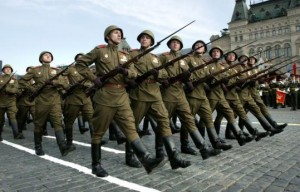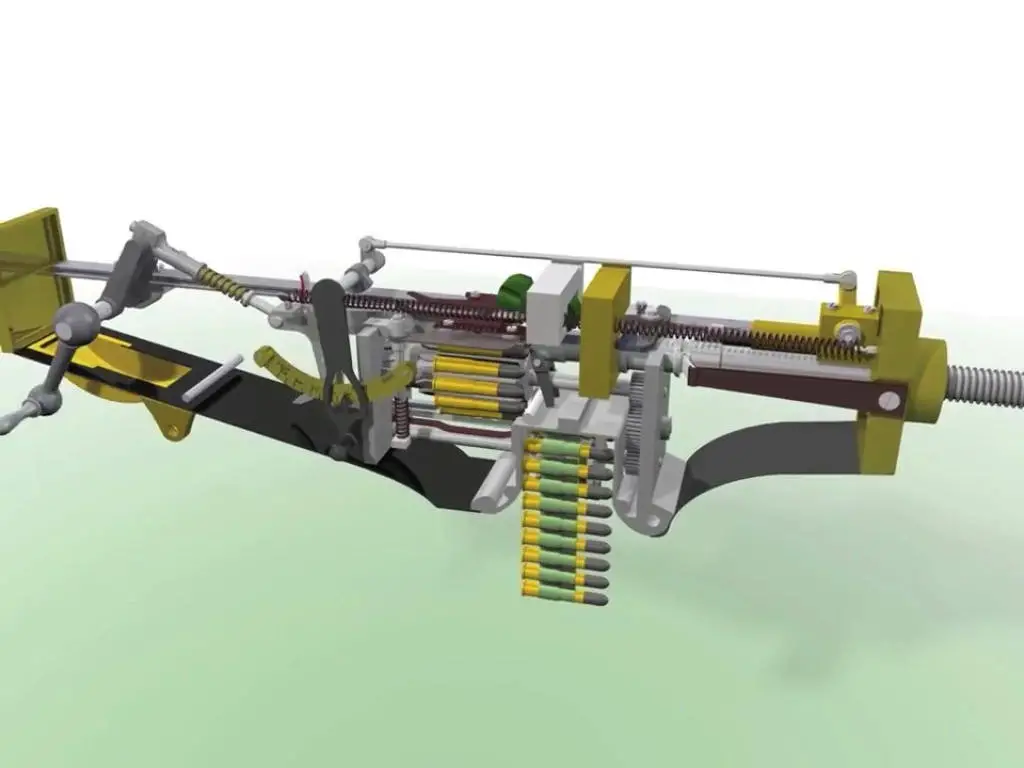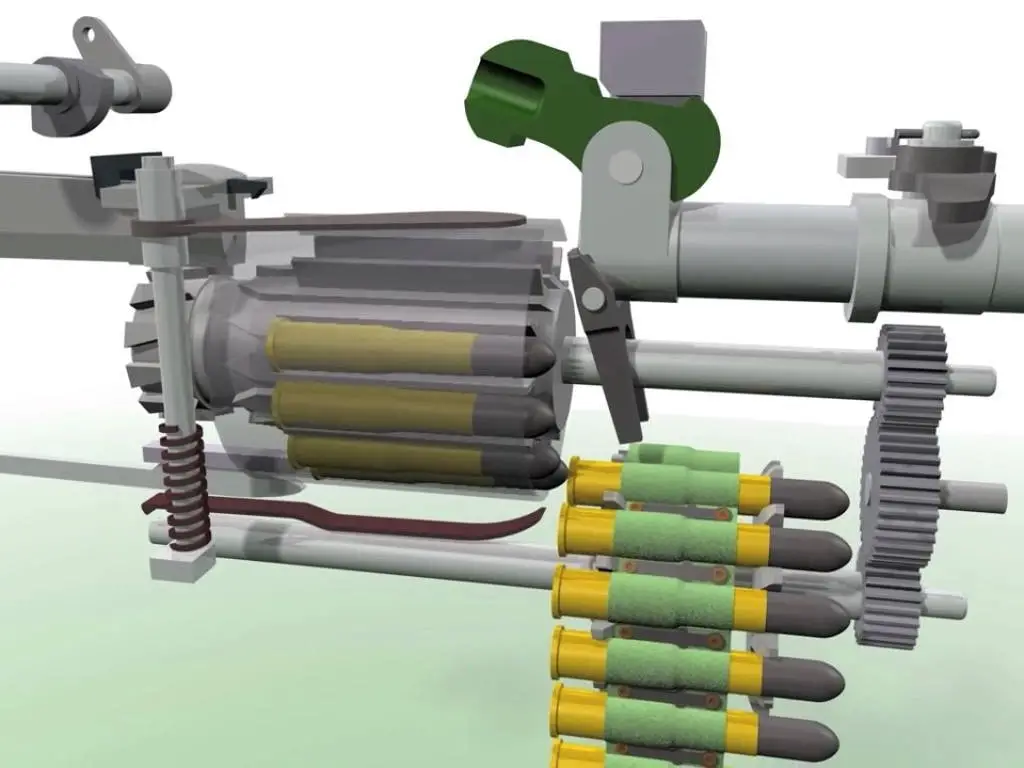… although, it could be called “Remembered Weapons,” because Ian remembers all the stuff that everybody else has forgotten. True, we haven’t flagged you to his site in, what, two whole days? But when he’s posting stuff like this, you need to be over there, not here. We’ll still be here posting several times a day, but trust us, you want to see these two posts, and you want to point your RSS reader at FW so you never miss stuff like this.
Item: The Grandpappy of all MGs
Every gun begins with the prototype — no, wait… Every gun begins with an idea, but it has to pass through the stage of prototype if it’s ever going to be made concrete and marketed, adopted, and/or produced. And Forgotten Weapons is starting a new series on the Maxim, the grandpappy of all machine guns, with a great post on the prototype, which is, naturally, the granddaddy of all Maxims.
One of the best parts of that post is a video Ian scared up which shows the ur-Maxim’s inner cuckoo clock. It’s ingenious, but it’s fair to say that the highly developed Maxim of the First World War was vastly simplified and improved over this design.
That, of course, just makes the engineering dead ends of the prototype even more interesting. There’s a little bit of similarity to the much later aerial weapon, the Mauser revolver cannon, in that a rotary sprocket is used to lift the cartridges after they are withdrawn by an extractor from the ammunition belt.
Item: Small Arms Development, 1945-65: the Soviet View

Victory Day parade. Rather than rest on their laurels, the Soviets overhauled their weapons after World War II, sending these Mosins to the warehouse, and by 1965 they’d done it a second time.
Ian got hold of a fascinating primary source document: a CIA translation of a classified Soviet analysis of small arms development after World War II. Both the intent of Soviet development and the differences between Soviet and NATO small arms doctrine and development objectives are laid bare in this document (available at the link).
Our long-held thesis that Soviet developments were primarily focused on putting automatic fire in the hands of their riflemen, whereas Western forces primarily focused on aimed semi-auto fire, is borne out from the horse’s mouth, as it were. The authors of the piece, two senior Soviet officers, see, from their point of view, 1965 NATO as making a serious error in not giving their riflemen weapons that can be effective in automatic fire at close range. Of the US Army:
[E]xperience in the operation of the M14 rifle has shown that it has extremely unsatisfactory grouping capability during automatic firing, as a result of which it is assigned to US troops only in the semiautomatic variant.
…in recent years the American army has renovated nearly all of its small arms. However, it should be pointed out that with the NATO cartridge as a basis, the USA has failed to solve the problem of developing a mobile and effective automatic individual weapon that satisfies the requirements of modern combat. For this reason the Americans have taken measures to modernize the M14 rifle, to explore other rifle designs, to develop a new 5.6-mm cartridge with reduced power, and to develop a rifle that will use this cartridge.
Ivan also prized light weight in his weaponry.
With allowance made for [the Soviets not being sure what NATO armies carried as a basic load of ammunition -Ed.] the average weight load (weapon plus unit of fire of cartridges being carried) per man amounts to: in the Soviet Army — 7.2 kilograms, in the US Army — 9.3 kilograms, in the West German Army — 10.9 kilograms, and in the French Army — 8.5 kilograms,
(This is referring to the M14 version of the US Army, the one that faced Russian occupation armies in Eastern Europe directly at the time. Elsewhere in the report, they note the emergence of the M16 as something to be watched).
Judged on the basis of these data, the weaponry of the Soviet Army is the lightest. This has been achieved by the use in our army of the 7,62-mm Model 1943 cartridge and the development for it of an automatic rifle and a light machinegun, which have made it possible to substantially lighten the weight of both the individual weapon itself and also the unit of fire carried with it.
Interesting to us that no credit at all is given to the Germans for inventing the intermediate cartridge and assault rifle concept. While the CETME rifle is mentioned as the source of the German G-3, there’s no mention that the CETME itself is an adaptation of the StG.45. (That fact may have been unknown to the Russian authors).
The authors were extremely satisfied with the state of Soviet weapons, and considered their weapons superior both individually to their counterparts, and on a unit vs. unit basis.

Kevin was a former Special Forces weapons man (MOS 18B, before the 18 series, 11B with Skill Qualification Indicator of S). His focus was on weapons: their history, effects and employment. He started WeaponsMan.com in 2011 and operated it until he passed away in 2017. His work is being preserved here at the request of his family.



11 thoughts on “Don’t Forget Forgotten Weapons…”
The guy is awesome. To put all that stuff together, that’s a serious lick of work and attention to detail. You can tell a lot of thinking and consideration never mind research, goes into what Ian does.
I hope Ian becomes successful beyond his wildest dreams.
I just wish I was him!! So many guns….. 🙂
The Soviet report is quite interesting to me. From a purely aesthetic viewpoint the Kalashnikov leaves me cold but I think the Soviets were really onto something – especially if they could force their enemies to fight the war they wanted; something I think woulda have been quite likely had they surged across the Fulda Gap.
The guy who did the Maxim prototype animation has a site full of early manual and automatic mg cut away animations. Might be worth some Wednesday love.
http://www.victorianshipmodels.com/
“Interesting to us that no credit at all is given to the Germans for inventing the intermediate cartridge and assault rifle concept”
It’s not suprising considering that germans actually invented neither.
The concept of intermediate cartridge and a light, automatic carbine to fire it was around since at least 1918. Germans were the first to mass-produce and issue such weapon system, but far from being original inventors.
And it does seem probable that the Russian developments paralleled, more than copied, the German ones. The M43 cartridge came too soon after the 7.92 x 33 to be a copy.
Unlike the Germans or Americans, though, Russia (well, the USSR) went all in for the intermediate caliber weapon.
Most interesting to me was their reasoning behind replacing the RPD (a weapon I personally like a lot) with the RPK. USMC just did something similar for similar reasons with M27 (HK416) replacing the M249 (FN Minimi) in the rifle squad. The Marines that made this decision probably had no idea that the Soviet Army did something very similar over 50 years ago!
The 7.62×41 was inspired by both 7.62×33 US m1 carbine and 7.92×33 PP Kurz. However, the cartridge itself was ain indigenous development with intent to outperform German round while maintaining adequate recoil and compact dimensions
>Most interesting to me was their reasoning behind replacing the RPD (a weapon I personally like a lot) with the RPK
I believe there was 3 major reasons:
1) economics (RPK was much cheaper to make and maintain than RPD)
2) reliability (RPD was sorta underpowered)
3) probable tactical scenarios of late 1950s, when Soviet Army was preparing for a full-scale, nuclear WW3. In small-unit encounters, a belt-fed weapon like RPD or M249 is probably preferable to a mag-fed autorifle like an RPK, RPK-74 or M27. But in a full-scale conflict, economics and logistic is more important than minor changes in small arms efectiveness
The economics of training had to count, also. It must have been very expensive for the huge Soviet Army to have to train every squad MG gunner (and probably, every soldier, at least for familiarity) on a weapon that had nothing in common (except cartridge) with the service rifle.
I could not impart my enthusiasm for the RPD to my Afghans. They wanted more PKMs instead, heavier, but much more firepower. All the RPDs we captured wound up sitting in a storage room with the other obsolete stuff.
same applies here
many “armchair commandos” are praising the RPD, while most real men who do the fighting generally prefer PKM or Petcheneg for their range, penetrating power and reliability
Of course, first assault rifle was the Fyodorov Avtomat. I have his book around somewhere, I wonder if he talks about that development.
In fact, Fedorov Avtomat was as much an “assu;t rifle” as its direct predecessor, French CSRG M1915 machine rifle, or American M1918 BAR
Fedorow intended his machine rifle to be built around full-power 6.5x57mm rimless round of his own design, which generated about 3100 Joules of muzzle energy with 8 gram bullet. Hardly an “intermediate” round by any standards.
Only the limitations of the wartime economics forced him to convert his design to a readily available and less powerful 6.5mm Arisaka round.
Not sure if you read it, but I posted my thoughts about the whole “assault rifle” concept at this link: http://world.guns.ru/assault-e.html